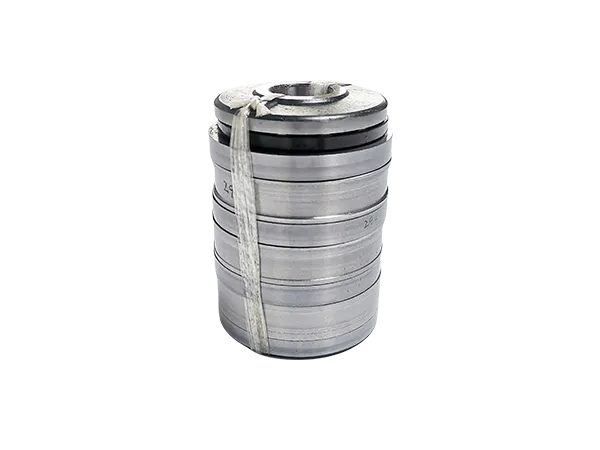An In-Depth Study of Six-Row Tandem Thrust Bearings
Introduction
Tandem thrust bearings play a crucial role in a variety of engineering applications, especially in high-load and high-speed machinery configurations. Among the various configurations of thrust bearings, the six-row tandem thrust bearing stands out due to its enhanced load-carrying capacity, stability, and performance under extreme conditions. This article delves into the advantages, applications, installation procedures, and characteristics of six-row tandem thrust bearings.
Advantages of Six-Row Tandem Thrust Bearings
- Increased Load Capacity: One of the primary advantages of six-row tandem thrust bearings is their ability to support higher axial loads compared to their fewer-row counterparts. The arrangement of six rows allows for a more distributed load, minimizing stress concentration and enhancing the overall durability of the bearing.
- Improved Stability: The design of six-row tandem thrust bearings offers improved stability, which is critical in dynamic applications. This stability helps to reduce vibrations and ensures smooth operation, extending the lifespan of the machinery.
- Reduced Friction: Advanced materials and precision engineering used in six-row tandem thrust bearings contribute to lower friction coefficients. Reduced friction translates to higher efficiency, less wear, and improved performance of rotating machinery.
- Versatility: Six-row tandem thrust bearings are versatile and can be customized to suit a variety of applications, making them ideal for industries that require specific engineering solutions.
Applications
Six-row tandem thrust bearings find application in numerous sectors, demonstrating their versatility and reliability. Some notable applications include:
- Marine Propulsion Systems: In large marine vessels, six-row tandem thrust bearings are essential components in propeller systems, providing the necessary support for thrust generated during navigation.
- Heavy Machinery: These bearings are commonly used in heavy-duty industrial machinery, such as excavators and crane systems, facilitating operation under significant axial loads.
- Turbomachinery: In turbines, whether used for power generation or aircraft propulsion, six-row tandem thrust bearings assist in managing the considerable axial forces generated during operation, ensuring efficient and stable performance.
- Cranes and Lifting Equipment: In cranes, six-row tandem thrust bearings are pivotal in handling the loads during lifting and swinging operations, thus enhancing safety and efficiency.
Installation Procedures
Proper installation is critical for the optimal performance of six-row tandem thrust bearings. The following steps outline the recommended installation process:
- Preparation: Before installation, ensure that the bearing surfaces and housing are clean and free from any debris or contaminants. Inspect both the bearing and housing for any signs of damage.
- Alignment: Proper alignment of the bearing assembly is paramount. Misalignment can lead to premature wear and failure. Use alignment tools to achieve precision during the installation process.
- Lubrication: Adequate lubrication is critical for the performance of six-row tandem thrust bearings. Select a suitable lubricant based on operating conditions and ensure that the bearing is well-lubricated before installation.
- Seating the Bearing: Carefully seat the bearing into its housing. Use a suitable method to prevent damage to the bearing during this stage. Ensure that the bearing is seated evenly without any gaps.
- Testing: After installation, conduct a thorough check to verify that the bearing operates smoothly. Monitor for noise, vibration, and temperature to ensure everything is functioning correctly.
Characteristics of Six-Row Tandem Thrust Bearings
The design and engineering of six-row tandem thrust bearings give rise to several important characteristics:
- Robust Construction: These bearings are constructed using high-strength materials, specifically designed to withstand harsh operational environments, including high temperatures and corrosive conditions.
- Self-Alignment: Advanced designs often incorporate self-aligning features, which help in maintaining alignment even under fluctuating loads, further extending their service life.
- Enhanced Thermal Management: The construction of six-row tandem thrust bearings allows for better heat dispersal. This characteristic is crucial in applications where thermal instability can lead to premature failure.
- Easy Maintenance: Many modern six-row tandem thrust bearings are designed for easy maintenance, allowing for quick lubrication and inspection without extensive disassembly.
Conclusion
The six-row tandem thrust bearing represents a significant advancement in bearing technology, offering numerous advantages over traditional bearing designs. With their increased load capacity, stability, and versatility, these bearings are indispensable in high-demand applications across various industries. By understanding their benefits, proper installation procedures, and distinctive characteristics, engineers and operators can maximize the performance and longevity of their machinery. As technology continues to evolve, the relevance of six-row tandem thrust bearings is likely to grow, making them a critical focus for future developments in mechanical engineering.



